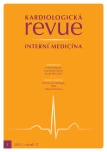Catheter‑based patent foramen ovale closure in divers
Authors:
J. Honěk
Authors‘ workplace:
Kardiologická klinika 2. LF UK a FN v Motole, Praha
Published in:
Kardiol Rev Int Med 2015, 17(1): 25-27
Category:
Cardiology Review
Overview
Patent foramen ovale (PFO) is associated with increased risk of decompression sickness (DCS) in divers due to paradoxical embolization of nitrogen bubbles from venous blood to systemic circulation. Despite the high prevalence of PFO, many important questions, including optimal screening, risk stratification and management strategy, remain unanswered. Recently published data suggest possible effectiveness of PFO closure as well as conservative diving measures in preventing arterial gas embolization. This review aims to introduce the basic principles of physiology and pathophysiology of bubble formation and to summarize current literature on PFO and diving and review the possibilities of management of symptomatic divers.
Keywords:
patent foramen ovale – catheter‑based closure – decompression sickness
Sources
1. Bove AA. The PFO gets blamed again…perhaps this time it is real. JACC Cardiovasc Interv 2014; 7: 409– 410. doi: 10.1016/ j.jcin.2014.01.152.
2. Hagen PT, Scholz DG, Edwards WD. Incidence and size of patent foramen ovale during the first 10 decades of life: an autopsy study of 965 normal hearts. Mayo Clin Proc 1984; 59: 17– 20.
3. Doolette DJ, Mitchell SJ. The physiological kinetics of nitrogen and the prevention of decompression sickness. Clin Pharmacokinet 2001; 40: 1– 14.
4. Papadopoulou V, Eckersley RJ, Balestra C et al. A critical review of physiological bubble formation in hyperbaric decompression. Adv Colloid Interface Sci 2013; 191– 192: 22– 30. doi: 10.1016/ j.cis.2013.02.002.
5. Bove AA. Diving medicine. Am J Respir Crit Care Med 2014; 189: 1479– 1486. doi: 10.1164/ rccm.201309‑ 1662CI.
6. Vann RD, Butler FK, Mitchell SJ et al. Decompression Illness. Lancet 2011; 377: 153– 164. doi: 10.1016/ S0140‑ 6736(10)61085‑ 9.
7. Dunford RG, Vann RD, Gerth WA et al. The incidence of venous gas emboli in recreational diving. Undersea Hyperb Med 2002; 29: 247– 259.
8. Ljubkovic M, Dujic Z, Møllerløkken A et al. Venous and arterial bubbles at rest after no‑ decompression air dives. Med Sci Sports Exerc 2011; 43: 990– 995. doi: 10.1249/ MSS.0b013e31820618d3.
9. Gempp E, Blatteau JE, Simon O et al. Musculoskeletal decompression sickness and risk of dysbaric osteonecrosis in recreational divers. Diving Hyperb Med 2009; 39: 200– 204.
10. Wilmshurst PT, Ellis PT, Jenkins BS. Paradoxical gas embolism in a scuba diver with an atrial septal defect. Br Med J 1986; 293: 1277.
11. Moon RE, Camporesi EM, Kisslo JA. Patent foramen ovale and decompression sickness in divers. Lancet 1989; 1: 513– 514.
12. Cantais E, Louge P, Suppini A et al. Right‑ to‑ left shunt and risk of decompression illness with cochleovestibular and cerebral symptoms in divers: case control study in 101 consecutive dive accidents. Crit Care Med 2003; 31: 84– 88.
13. Wilmshurst PT, Pearson MJ, Walsh KP et al. Relationship between right‑ to‑ left shunts and cutaneous decompression illness. Clin Sci 2001; 100: 539– 542.
14. Germonpré P, Dendale P, Unger P et al. Patent foramen ovale and decompression sickness in sports divers. J Appl Physiol 1998; 84: 1622– 1626.
15. Torti SR, Billinger M, Schwerzmann M et al. Risk of decompression illness among 230 divers in relation to the presence and size of patent foramen ovale. Eur Heart J 2004; 25: 1014– 1020.
16. Knauth M, Ries S, Pohimann S et al. Cohort study of multiple brain lesions in sport divers: role of a patent foramen ovale. BMJ 1997; 314: 701– 705.
17. Marabotti C, Scalzini A, Menicucci D et al. Cardiovascular changes during SCUBA diving: an underwater Doppler echocardiographic study. Acta Physiol 2013. doi: 10.1111/ apha.12112.
18. Gempp E, Louge P, Blatteau JE et al. Risks factors for recurrent neurological decompression sickness in recreational divers: a case‑ control study. J Sports Med Phys Fitness 2012; 52: 530– 536.
19. Ljubkovic M, Zanchi J, Breskovic T et al. Determinants of arterial gas embolism after scuba diving. J Appl Physiol 2012; 112: 91– 95. doi: 10.1152/ japplphysiol.00943.2011.
20. Cartin‑Ceba R, Swanson KL, Krowka MJ. Pulmonary arteriovenous malformations. Chest 2013; 144: 1033– 1044. doi: 10.1378/ chest.12‑ 0924.
21. Billinger M, Zbinden R, Mordasini R et al. Patent foramen ovale closure in recreational divers: effect on decompression illness and ischaemic brain lesions during long‑term follow‑up. Heart 2011; 97: 1932– 1937. doi: 10.1136/ heartjnl‑ 2011‑ 300436.
22. Walsh KP, Wilmshurst PT, Morrison WL. Transcatheter closure of patent foramen ovale using the Amplatzer septal occluder to prevent recurrence of neurological decompression illness in divers. Heart 1999; 81: 257– 261.
23. Lairez O, Cournot M, Minville V et al. Risk of neurological decompression sickness in the diver with right‑ to‑ left shunt: literature review and meta‑analysis. Clin J Sport Med 2009; 19: 231– 235. doi: 10.1097/ JSM.0b013e31819b0fa2.
24. Honěk J, Šrámek M, Šefc L et al. Effect of catheter‑based patent foramen ovale closure on the occurrence of arterial bubbles in scuba divers. JACC Cardivasc Interv 2014; 7: 403– 408. doi: 10.1016/ j.jcin.2013.12.199.
25. Honěk J, Šrámek M, Šefc L et al. Effect of conservative dive profiles on the occurrence of venous and arterial bubbles in divers with a patent foramen ovale: a pilot study. Int J Cardiol 2014; 176: 1001– 1002. doi: 10.1016/ j.ijcard.2014.04.218.
26. Klingmann C, Rathmann N, Hausmann D et al. Lower risk of decompression sickness after recommendation of conservative decompression practices in divers with and without vascular right‑ to‑ left shunt. Diving Hyperb Med 2012; 42: 146– 150.
27. Gempp E, Blatteau JE. Preconditioning methods and mechanisms for preventing the risk of decompression sickness in scuba divers: a review. Res Sports Med 2010; 18: 205– 218. doi: 10.1080/ 15438627.2010.490189.
Labels
Paediatric cardiology Internal medicine Cardiac surgery CardiologyArticle was published in
Cardiology Review

2015 Issue 1
Most read in this issue
- TDM of digoxin in clinical practice
- Drug interaction and current clinical practice
- Cardiac resynchronization therapy – when should it be indicated and for whom?
- TDM of antibiotics in clinical practice
